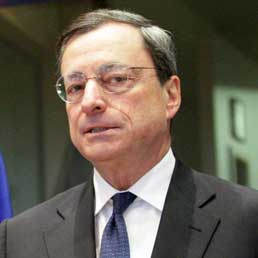Storia dell'articolo
Chiudi
Questo articolo è stato pubblicato il 15 aprile 2013 alle ore 15:55.

Speech by Mario Draghi, President of the ECB, at the "Room for discussion" of the Study Association SEFA and the Faculty of Economics and Business, Amsterdam,15 April 2013
Introduction
There was a time, not too long ago, when central banking was considered to be a rather boring and unexciting occupation. In the era of the "Great Moderation", mostly seen as the period between the mid-1980s and the beginning of the global financial crisis, inflation was tamed and macroeconomic volatility was contained. Some thought that monetary policy could effectively be placed on auto-pilot. I can confidently say that this time has passed.
The ECB's monetary policy in the crisis
The global financial crisis has put an end to that period in a way that has been very abrupt and certainly lasting for quite some time to come. In this country, the outbreak of a financial crisis brings back memories that go quite far into history. In 1763, exactly 250 years ago, Amsterdam was the centre of a deep financial crisis. Highly leveraged investors were faced with a situation of falling asset prices. The rolling over of existing obligations became very difficult and the liquidity crisis became severe. Investors could not refinance themselves other than through fire sales of distressed assets. Amsterdam bank houses went bankrupt and merchants suffered significant losses. [1]
The 1763 crisis has some important resemblances with today's crisis. In the first stage of today's crisis, liquidity was at the epicentre. Money markets seized up and several market participants found themselves unable to roll-over funding positions. Concerns regarding bank solvency rapidly surfaced and the crisis then morphed into a banking crisis. Finally, at the beginning of 2010 the latest turn: several euro area countries' debt and deficit levels were found to be unsustainable. It was a sovereign debt crisis.
But differently from the crisis in 1763, the determined actions of central banks prevented the destructive downward spiral of abrupt deleveraging, fire sales and ultimately deflation. The ECB, and indeed all major central banks, reduced its policy rates to unprecedented lows. In addition, the ECB has implemented various non-standard measures to restore monetary policy transmission, also with a view to supporting credit flows to the real economy. This is a necessary pre-condition for fulfilling our ultimate objective of lasting price stability.
Our liquidity support gives banks unlimited access to central bank money at a fixed price against adequate collateral. To make it fully flexible and facilitate banks in their attempt to liquefy their assets at times of stress, we expanded the set of eligible assets that can be used as collateral.
©RIPRODUZIONE RISERVATA









